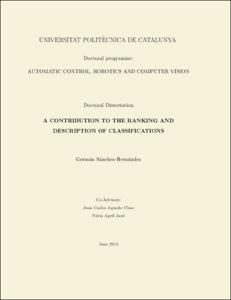Mostra el registre d'ítem simple
A contribution to the ranking and description of classifications
| dc.contributor | Aguado Chao, Juan Carlos |
| dc.contributor | Agell Jané, Núria |
| dc.contributor.author | Sánchez Hernández, Germán |
| dc.contributor.other | Universitat Politècnica de Catalunya. Institut d'Organització i Control de Sistemes Industrials |
| dc.date.accessioned | 2014-05-22T11:29:15Z |
| dc.date.available | 2014-05-22T11:29:15Z |
| dc.date.issued | 2013-09-13 |
| dc.identifier.citation | Sánchez Hernández, G. A contribution to the ranking and description of classifications. Tesi doctoral, UPC, Institut d'Organització i Control de Sistemes Industrials, 2013. DOI 10.5821/dissertation-2117-95253. |
| dc.identifier.uri | http://hdl.handle.net/2117/95253 |
| dc.description.abstract | This thesis presents a novel and complete fuzzy multi-criteria decision making (MCDM) methodology. This methodology is specifically designed for selecting classifications in the framework of unsupervised learning systems. The main results obtained are twofold. On the one hand, the definition of fuzzy criteria to be used to assess the suitability of a set of given classifications and, on the other hand, the design and development of a natural language generation (NLG) system to qualitatively describe them. Unsupervised learning systems often produce a large number of possible classifications. In order to select the most suitable one, a set of criteria is usually defined and applied sequentially to assess and filter the obtained classifications. This is done, in general, by using a true-false decision in the application of each criterion. This approach could result in classifications being discarded and not taken into account when they marginally fail to meet one particular criterion even though they meet other criteria with a high score. An alternative solution to this sequential approach has been introduced in this thesis. It consists of evaluating the degree up to which each fuzzy criterion is met by each classification and, only after this, aggregating for each classification the individual assessments. This overall value reflects the degree up to which the set of criteria is globally satisfied by each classification. Five fuzzy criteria are defined and analysed to be used collectively to evaluate classifications. The corresponding single evaluations are then proposed to be aggregated into a collective one by means of an Ordered Weighted Averaging (OWA) operator guided by a fuzzy linguistic quantifier, which is used to implement the concept of fuzzy majority in the selection process. In addition, a NLG system to qualitatively describe the most important characteristics of the best classification is designed and developed in order to fully understand the chosen classification. Finally, this new methodology is applied to a real business problem in a marketing context. The main purpose of this application is to show how the proposed methodology can help marketing experts in the design of specific-oriented marketing strategies by means of an automatic and interpretable segmentation system. |
| dc.format.extent | 203 p. |
| dc.language.iso | eng |
| dc.publisher | Universitat Politècnica de Catalunya |
| dc.rights | L'accés als continguts d'aquesta tesi queda condicionat a l'acceptació de les condicions d'ús establertes per la següent llicència Creative Commons: http://creativecommons.org/licenses/by-nc/3.0/es/ |
| dc.rights.uri | http://creativecommons.org/licenses/by-nc/3.0/es/ |
| dc.source | TDX (Tesis Doctorals en Xarxa) |
| dc.subject | Àrees temàtiques de la UPC::Enginyeria civil |
| dc.title | A contribution to the ranking and description of classifications |
| dc.type | Doctoral thesis |
| dc.identifier.doi | 10.5821/dissertation-2117-95253 |
| dc.identifier.dl | B 13725-2014 |
| dc.rights.access | Open Access |
| dc.description.version | Postprint (published version) |
| dc.identifier.tdx | http://hdl.handle.net/10803/134802 |


